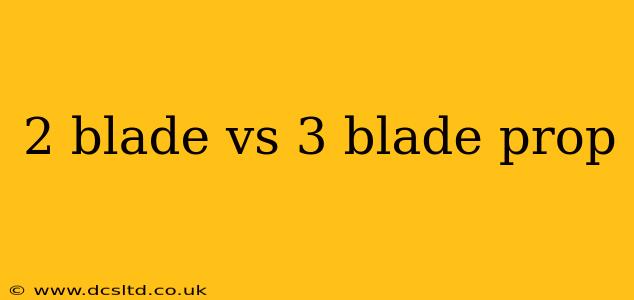Choosing between a 2-blade and a 3-blade propeller can significantly impact your boat's performance. While both types propel your vessel forward, their characteristics differ, leading to varying levels of efficiency, speed, and handling. This comprehensive guide will delve into the key differences, helping you make an informed decision based on your specific boating needs.
What are the Key Differences Between 2-Blade and 3-Blade Props?
The primary difference lies in the number of blades. This seemingly small variation affects several aspects of propeller performance:
-
Thrust: 3-blade propellers generally produce higher thrust at lower RPMs. This is beneficial for quicker acceleration and better hole shot (initial acceleration from a standstill). 2-blade props, conversely, often offer better top-end speed due to reduced drag.
-
Efficiency: Efficiency is a complex factor. While 3-blade props excel in thrust, their additional blade can introduce slightly more drag at higher speeds. 2-blade propellers, with less surface area in contact with the water, typically show higher efficiency at higher speeds. The "best" efficiency will depend on your boat and its operating speed range.
-
Noise & Vibration: Generally, 3-blade propellers generate more noise and vibration than 2-blade props. This is due to the increased surface area interacting with the water and the more complex hydrodynamic forces at play.
-
Fuel Consumption: This depends heavily on the application and boat type. A more efficient propeller (either 2 or 3 blade) generally leads to better fuel economy, however, other factors, like boat hull design and engine performance outweigh the propeller's impact.
-
Cavitation: Cavitation (the formation of vapor bubbles due to low pressure) can occur with both types, but the risk might be slightly higher with a 2-blade prop, especially at higher speeds. This can lead to reduced efficiency and damage over time.
Which Propeller is Better for Specific Boating Activities?
The optimal propeller type depends largely on your typical boating activities:
-
Fishing Boats: For trolling and slow-speed maneuvering, a 3-blade propeller often provides superior control and thrust at lower RPMs. This is advantageous for precise positioning and maintaining a steady speed while fishing.
-
High-Speed Boats: For applications demanding maximum speed, a 2-blade propeller might be preferred, as the reduced drag contributes to higher top-end performance. This is common among racing boats and those prioritizing speed above all else.
-
Cruisers: Cruisers often benefit from a 3-blade prop for balanced performance, combining sufficient thrust for acceleration with reasonable fuel efficiency at cruising speeds.
What is the Impact of Pitch and Diameter?
The number of blades is only one part of the equation. Pitch and diameter also significantly influence performance:
-
Pitch: Pitch refers to the distance the propeller would theoretically advance in one revolution. Higher pitch propellers offer greater top speed, while lower pitch propellers provide more thrust at lower RPMs.
-
Diameter: The diameter determines the amount of water the propeller engages. Larger diameter propellers typically deliver more thrust but can also increase drag.
How Do I Choose the Right Propeller?
Selecting the correct propeller involves considering various factors:
-
Boat type and size: Different boats have different hull designs and require different propeller characteristics.
-
Engine type and horsepower: The engine's power output influences the propeller's optimal size and pitch.
-
Desired performance: Prioritize speed, fuel economy, or maneuverability based on your usage.
Consulting a marine professional or using a propeller selection calculator can help you determine the ideal propeller for your specific boat and application.
What Materials Are Propellers Made From?
Propellers are typically made from several materials, each with its own advantages and disadvantages:
-
Aluminum: Cost-effective and relatively durable, but more prone to damage than stainless steel.
-
Stainless Steel: More durable and resistant to corrosion, but more expensive than aluminum.
-
Nickel Aluminum Bronze (NAB): This more exotic material combines strength, corrosion resistance, and wear properties, but it typically commands a higher price point.
Frequently Asked Questions (FAQ)
Can I switch from a 2-blade to a 3-blade propeller easily?
Yes, but it might require some adjustments to the engine settings. It's recommended to have a marine professional help with this switch to ensure proper installation and engine calibration.
Does a 3-blade propeller always provide better fuel economy?
Not necessarily. While 3-blade propellers often provide better thrust at lower RPMs (allowing for potentially lower engine speeds at cruising speed), the extra blade can also increase drag at higher speeds, potentially offsetting fuel savings. The overall effect on fuel economy is highly dependent on the specific boat, engine, and operating conditions.
What are the signs that I need a new propeller?
Signs of a worn or damaged propeller include unusual vibrations, reduced performance, cavitation, or visible damage to the blades.
This guide provides a comprehensive overview of the differences between 2-blade and 3-blade propellers. Remember to always consult with a marine professional to ensure you select the optimal propeller for your specific needs and boating style.
